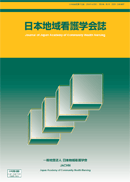Volume 11, Issue 2
Displaying 1-12 of 12 articles from this issue
- |<
- <
- 1
- >
- >|
-
Article type: Article
2009 Volume 11 Issue 2 Pages 7-14
Published: March 31, 2009
Released on J-STAGE: April 20, 2017
Download PDF (1273K) -
Article type: Article
2009 Volume 11 Issue 2 Pages 15-24
Published: March 31, 2009
Released on J-STAGE: April 20, 2017
Download PDF (1218K) -
Article type: Article
2009 Volume 11 Issue 2 Pages 25-30
Published: March 31, 2009
Released on J-STAGE: April 20, 2017
Download PDF (961K) -
Article type: Article
2009 Volume 11 Issue 2 Pages 31-37
Published: March 31, 2009
Released on J-STAGE: April 20, 2017
Download PDF (863K) -
Article type: Article
2009 Volume 11 Issue 2 Pages 38-45
Published: March 31, 2009
Released on J-STAGE: April 20, 2017
Download PDF (1365K) -
Article type: Article
2009 Volume 11 Issue 2 Pages 46-51
Published: March 31, 2009
Released on J-STAGE: April 20, 2017
Download PDF (998K) -
Article type: Article
2009 Volume 11 Issue 2 Pages 52-58
Published: March 31, 2009
Released on J-STAGE: April 20, 2017
Download PDF (1101K) -
Article type: Article
2009 Volume 11 Issue 2 Pages 59-67
Published: March 31, 2009
Released on J-STAGE: April 20, 2017
Download PDF (1131K) -
Article type: Article
2009 Volume 11 Issue 2 Pages 68-73
Published: March 31, 2009
Released on J-STAGE: April 20, 2017
Download PDF (843K) -
Article type: Article
2009 Volume 11 Issue 2 Pages 74-79
Published: March 31, 2009
Released on J-STAGE: April 20, 2017
Download PDF (937K) -
Article type: Article
2009 Volume 11 Issue 2 Pages 80-86
Published: March 31, 2009
Released on J-STAGE: April 20, 2017
Download PDF (977K) -
Article type: Article
2009 Volume 11 Issue 2 Pages 87-92
Published: March 31, 2009
Released on J-STAGE: April 20, 2017
Download PDF (886K)
- |<
- <
- 1
- >
- >|
